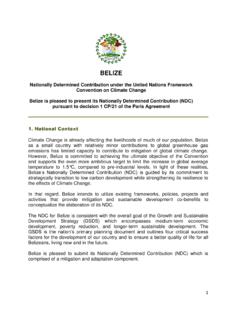Transcription of COMMENTARY Paris Agreement - IRADe
1 COMMENTARYE conomic & Political Weekly EPW april 9, 2016 vol lI no 1521 Paris Agreement Differentiation without Historical Responsibility?Kirit S Parikh, Jyoti K ParikhKirit S Parikh is Chair, Integrated Research and Action for Development, and Former Member, Planning Commission. Jyoti K Parikh is Executive Director, Integrated Research and Action for Paris Agreement on Climate Change has reiterated the principle of Common but Differentiated Responsibilities and Respective Capabilities, but has not referred to historical responsibility. How important is historical responsibility and what does it imply? How is one going to differentiate without historical responsibility? What would be India s responsibility? How do India s Intended Nationally Determined Contribution targets compare with its responsibility?
2 India submitted its Intended Nation-ally Determined Contributions (INDCs) on 1 October 2015 to the United Nations Framework Convention on Cli-mate Change (UNFCCC) (Government of India 2015). Countries were asked to submit their own INDCs before the Paris Conference of Parties (COP). The process of INDC preparation invo lved modelling studies by two dif-ferent groups Integrated Research and Action for Development ( IRADe ) and T he Energy and Resources Institute (TERI) with frequent consultations with the Ministry of Environment, Forest, and Climate Cha nge (MoEFCC) offi cials. Var-ious ministries were also consulted to get their viewpoints on the possibilities in their sectors. The earlier report of the expert group on low carbon strategy for inclusive growth was also considered (Parikh et al 2014).
3 India s INDC aims to reduce its emission intensity (that is, the amount of carbon dioxide [CO2] emitted per unit of gross domestic product [GDP]) by 30% 35% by 2030, compared to that in 2005. It also aspires to increase non-fossil-based power generation capacity by 40% by 2030. An additional carbon sink equi-valent of 3 billion tonnes of CO2 through additional forest and tree cover will be s INDC also states that it can achieve these targets if low-cost fi nance and technology are provided. It assesses that $ trillion (at 2014 15 prices) is required for meeting India s climate change actions between now and 2030. We argue here that India s INDCs are ambitious and much above what India s responsibility for climate change requ ires. We believe that the goals are attainable, but at some cost.
4 We also argue that some of the comments on India s INDC made by some people are misplaced. For example, Navroz K Dubash and Radhika Khosla (2015) have argued that the esti-mate of cost of the low carbon measure in the INDC is an overestimate as co-benefi ts of these measures are not accounted for. India s INDCs are also criticised by Nagraj Adve and Ashish Kothari (2015) as not being ambitious enough to lead to a global Agreement , and that this would not take care of the poor in India as it does not emphasise distributed renewable energy (DRE).Are These Targets Achievable?Reducing emissions intensity by 35% in 25 years requires an annual reduction of With the number of measures India has already taken for energy effi -ciency and for renewable energy, our emissions intensity has been coming down at a much faster rate.
5 Our emissions grew during 2005 12 by around per year (WRI CAIT 2014), while our GDP grew at over 8% per year, implying emission intensity reduction of over 6% per year. Thus, the target is realisable. Could we have made a more ambi-tious commitment? We could have, but at considerable costs. Even the target of 35% reduction is estimated to cost a lot. Are the costs overestimated as it does not account for co-benefi ts?The Co-benefi ts ApproachThe notion of co-benefi ts is not strictly applicable to conditions in India. The co-benefi ts of reducing CO2 emissions by greater use of renewables, replacing coal-based power plants, to generate power are less local pollution and creation of employment. Local air pollution from a coal-based plant can be controlled by end-of-pipe measures, which are far less expensive than replacing a coal-based plant by a solar or a wind plant.
6 The United States (US) uses more coal than India. It gene-rated around 1,610 bkWh (billion kilowatt-hours) of electricity using coal in 2014 (US Energy Information Administration 2015), compared to around 855 bkWh generated by India using coal in 2013 14 (Central Statistics Offi ce 2015). The US plants keep local air pollution from coal plants under control. India can also do 9, 2016 vol lI no 15 EPW Economic & Political Weekly22 Replacing coal-based generation by solar and wind may actually increase emissions from coal-based generation. Since solar and wind power are available only for a part of the day, balancing with a coal-based plant will require that coal plants are run at varying capacity levels. This increases coal consumption and also related emissions.
7 This has actually happened in Germany (Carlyle 2013).The other co-benefi t of renewables is claimed to be generation of employment. This may be true in the US or Europe where coal mines are highly mechanised and the installed generating capa city hardly needs any expansion. Building a renewable plant would be additional in-vestment. However, in India, we need to add generating capacity. Also, our coal mining employs many more persons per tonne of coal than in the US or Europe, and a renewable plant may not generate more employment. The productivity at Coal India, based on production of 2014 15 and employee strength as of January 2016, is tonnes per employee hour,1compared to short tonnes per em-ployee hour in the US in Of course one could argue that we should make coal mining more effi cient.
8 Even then, we would employ more people per tonne of coal mined than in the US or Europe-an Union (EU). Also, solar and wind plantoperations require hardly any is, therefore, quite unlikely that build-ing a renewable plant instead of a new coal plant would create more employ-ment in India. As told to us by a builder of a solar photovoltaic (PV) plant in Delhi, the construction of a 1 MW PV solar plant requires 20 persons for four months. Surely, the construction of a coal-based power plant generates much more employment. Manisha Jain and Anand Patwar dhan (2013) assess the employ-ment in manufacture, fabrication, instal-lation and maintenance of a solar PVplant to range from to 13 persons per MW of a centralised plant, and from to persons for decentralised instal-lations.
9 Their estimate of jobs created in a biomass-based plant (which may be less than a coal-based plant) ranges from to persons per MW for a large plant (average size 6 MW), and from 414 to 737 persons per MW for smaller plants (average size 20 KW). The co-benefi ts of em-ployment for solar powerdo not seem to be borne out for have to recognise that a renewable plant costs more. For example, a solar plant requires twice as much invest-ment per KW as a coal plant. Also, a 1 KW solar plant will generate 1,600units of energy, whereasa coal-based plant could generate 6,000 to 7,000 units per year. Thus, to replace a 1 KW coal plant we need to invest in a solar plant of around 4 KW, requiring eight times as much in-vestment. Thus, the co-benefi ts should be compared with the co-costs.
10 For India, it is not obvious that co-benefi ts signifi -cantly reduce co-costs. Differentiating ResponsibilityBefore we compare India s INDC targets to its responsibility, we need to know what the latter is. Responsibility of countries could be based on per capita emissions, per capita GDP, or on how much they have contributed to the stock of green-house gases (GHGs) in the atmosphere. If we consider per capita emissions or per capita GDP, we need to relate them to re-sponsibility, whereas responsibility can be directly proportional to stock of GHGs, as it is the stock of GHGs that causes warming. Even when we look at the cur-rent stock of GHGs in the atmosphere, a reference to past emissions is unavoida-ble as to assess how much has been con-tributed by whom. Thus, differentiation without historical responsibility will be a non-starter.







